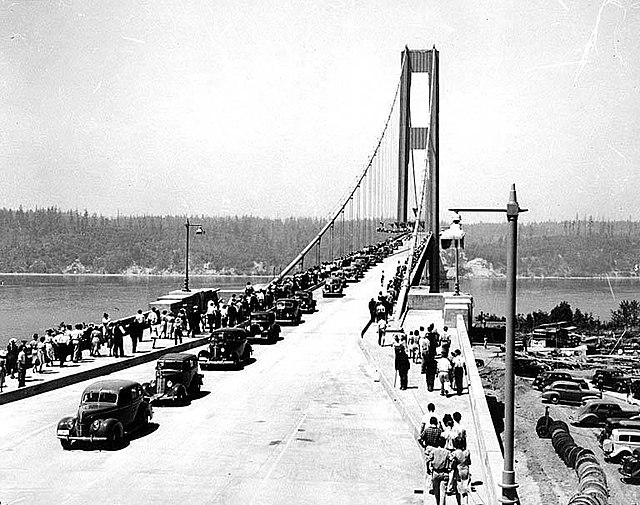Tacoma Narrows Bridge (1940)
The 1940 Tacoma Narrows Bridge, the first bridge at this location, was a suspension bridge in the U.S. state of Washington that spanned the Tacoma Narrows strait of Puget Sound between Tacoma and the Kitsap Peninsula. It opened to traffic on July 1, 1940, and dramatically collapsed into Puget Sound on November 7 of the same year. The bridge's collapse has been described as "spectacular" and in subsequent decades "has attracted the attention of engineers, physicists, and mathematicians". Throughout its short existence, it was the world's third-longest suspension bridge by main span, behind the Golden Gate Bridge and the George Washington Bridge.
The original Tacoma Narrows Bridge on its opening day on July 1, 1940
Program for the opening of the Tacoma Narrows Bridge, June 30, 1940
The main bridge span falling into the strait on November 7, 1940
A fragment of the collapsed bridge, in the Washington State History Museum in Tacoma
The Tacoma Narrows Bridge is a pair of twin suspension bridges that span the Tacoma Narrows strait of Puget Sound in Pierce County, Washington. The bridges connect the city of Tacoma with the Kitsap Peninsula and carry State Route 16 over the strait. Historically, the name "Tacoma Narrows Bridge" has applied to the original bridge nicknamed "Galloping Gertie", which opened in July 1940, but collapsed possibly because of aeroelastic flutter four months later, as well as the replacement of the original bridge which opened in 1950 and still stands today as the westbound lanes of the present-day two-bridge complex.
The bridges in 2015, as seen from the Tacoma side. 1950 bridge on the right, 2007 bridge on the left.
Opening day, July 1, 1940
The westbound span in 1988.
The eastbound span in 2013.







